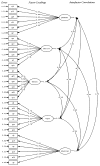Further validation of the multidimensional fatigue symptom inventory-short form
- PMID: 14711465
- PMCID: PMC2547485
- DOI: 10.1016/j.jpainsymman.2003.06.003
Further validation of the multidimensional fatigue symptom inventory-short form
Abstract
A growing body of evidence is documenting the multidimensional nature of cancer-related fatigue. Although several multidimensional measures of fatigue have been developed, further validation of these scales is needed. To this end, the current study sought to evaluate the factorial and construct validity of the 30-item Multidimensional Fatigue Symptom Inventory-Short Form (MFSI-SF). A heterogeneous sample of 304 cancer patients (mean age 55 years) completed the MFSI-SF, along with several other measures of psychosocial functioning including the MOS-SF-36 and Fatigue Symptom Inventory, following the fourth cycle of chemotherapy treatment. The results of a confirmatory factor analysis indicated the 5-factor model provided a good fit to the data as evidenced by commonly used goodness of fit indices (CFI 0.90 and IFI 0.90). Additional evidence for the validity of the MFSI-SF was provided via correlations with other relevant instruments (range -0.21 to 0.82). In sum, the current study provides support for the MFSI-SF as a valuable tool for the multidimensional assessment of cancer-related fatigue.
Figures
Similar articles
-
Validity of the multidimensional fatigue symptom inventory-short form in an African-American community-based sample.Ethn Health. 2014;19(6):631-44. doi: 10.1080/13557858.2014.885933. Epub 2014 Feb 17. Ethn Health. 2014. PMID: 24527980 Free PMC article.
-
Psychometric properties and measurement equivalence of the Multidimensional Fatigue Syndrome Inventory- Short Form (MFSI-SF) amongst breast cancer and lymphoma patients in Singapore.Health Qual Life Outcomes. 2018 Jan 19;16(1):20. doi: 10.1186/s12955-018-0846-6. Health Qual Life Outcomes. 2018. PMID: 29351803 Free PMC article.
-
Systematic review of the multidimensional fatigue symptom inventory-short form.Support Care Cancer. 2015 Jan;23(1):191-212. doi: 10.1007/s00520-014-2389-7. Epub 2014 Aug 22. Support Care Cancer. 2015. PMID: 25142703 Review.
-
European Portuguese Version of the Multidimensional Fatigue Symptom Inventory-Short Form: Validation Study.Acta Med Port. 2023 Nov 2;36(11):723-730. doi: 10.20344/amp.18797. Epub 2023 Feb 22. Acta Med Port. 2023. PMID: 36812654
-
Review article: a systematic review of cancer-related fatigue measurement questionnaires.Am J Hosp Palliat Care. 2011 Mar;28(2):119-29. doi: 10.1177/1049909110381590. Epub 2010 Nov 4. Am J Hosp Palliat Care. 2011. PMID: 21051784 Review.
Cited by
-
Current status and influencing factors of kinesiophobia in patients with peritoneal dialysis: a multicenter cross-sectional study.BMC Nephrol. 2024 Nov 11;25(1):404. doi: 10.1186/s12882-024-03851-0. BMC Nephrol. 2024. PMID: 39529009 Free PMC article.
-
Managing Vitality, Sustainable Performance and Fatigue in Nursing Home Staff: A Multi-Location Cross-Sectional Survey Study: Empirical Research Quantitative.Nurs Open. 2024 Oct;11(10):e70052. doi: 10.1002/nop2.70052. Nurs Open. 2024. PMID: 39445549 Free PMC article.
-
Changes in S100 calcium-binding protein β (S100β) and cognitive function from pre- to post-chemotherapy among women with breast cancer.Brain Behav Immun Health. 2024 Sep 8;41:100860. doi: 10.1016/j.bbih.2024.100860. eCollection 2024 Nov. Brain Behav Immun Health. 2024. PMID: 39391795 Free PMC article.
-
Are Sirtuins 1 and 2 Relevant Players in Relapsing-Remitting Multiple Sclerosis?Biomedicines. 2024 Sep 5;12(9):2027. doi: 10.3390/biomedicines12092027. Biomedicines. 2024. PMID: 39335541 Free PMC article.
-
Effects of Defatted Rice Bran-Fortified Bread on the Gut Microbiota Composition of Healthy Adults With Low Dietary Fiber Intake: Protocol for a Crossover Randomized Controlled Trial.JMIR Res Protoc. 2024 Aug 29;13:e59227. doi: 10.2196/59227. JMIR Res Protoc. 2024. PMID: 39207833 Free PMC article. Clinical Trial.
References
-
- Portenoy RK, Itri LM. Cancer-related fatigue: guidelines for evaluation and management. Oncologist. 1999;4:1–10. - PubMed
-
- Cella DF, Peterman A, Passik S, et al. Progress toward guidelines for the management of fatigue. Oncology (Huntingt) 1998;12(11A):369–377. - PubMed
-
- Cella DF. Factors influencing quality of life in cancer patients: anemia and fatigue. Semin Oncol. 1998;25(3Suppl 7):43–46. - PubMed
-
- Cimprich B. Development of an intervention to restore attention in cancer patients. Cancer Nurs. 1993;16(2):83–92. - PubMed
-
- Rhodes VA, Watson PM, Hanson BM. Patients’ descriptions of the influence of tiredness and weakness on self-care abilities. Cancer Nurs. 1988;11(3):186–194. - PubMed
Publication types
MeSH terms
Grants and funding
LinkOut - more resources
Full Text Sources
Other Literature Sources
Medical
Miscellaneous



